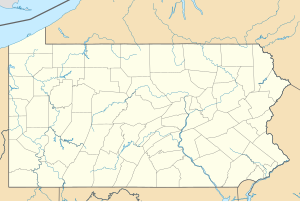Larrys Creek
| Larrys Creek | |
|
Larrys Creek and the Cogan House Covered Bridge in Cogan House Township, Pennsylvania
|
|
| Name origin: Larry Burt, first settler | |
| Country | United States |
|---|---|
| State | Pennsylvania |
| County | Lycoming |
| Source | near the hamlet of Steam Valley |
| - location | Cogan House Township, Lycoming County, Pennsylvania |
| - elevation | 1,740 ft (530 m) |
| - coordinates | 41°27′13″N 77°08′12″W / 41.45361°N 77.13667°W |
| Mouth | West Branch Susquehanna River |
| - location | Piatt Township, Lycoming County, Pennsylvania |
| - elevation | 515 ft (157 m) |
| - coordinates | 41°13′00″N 77°13′13″W / 41.21667°N 77.22028°WCoordinates: 41°13′00″N 77°13′13″W / 41.21667°N 77.22028°W |
| Length | 22.9 mi (36.9 km) |
| Basin | 89.1 sq mi (230.8 km2) |
| Discharge | for Mouth |
| - average | 66.0 cu ft/s (1.87 m3/s) |
| - max | 114 cu ft/s (3.23 m3/s) |
| - min | 8.8 cu ft/s (0.25 m3/s) |
|
Map showing Larrys Creek, its major tributaries and watershed
|
|
Larrys Creek is a 22.9-mile-long (36.9 km)tributary of the West Branch Susquehanna River in Lycoming County in the U.S. state of Pennsylvania. A part of the Chesapeake Bay drainage basin, its watershed drains 89.1 square miles (231 km2) in six townships and a borough. The creek flows south from the dissected Allegheny Plateau to the Ridge-and-valley Appalachians through sandstone, limestone, and shale from the Devonian, Mississippian, and Pennsylvanian periods.
The valley's first recorded inhabitants were the Susquehannocks, followed by the Lenape and other tribes. The Great Shamokin Path crossed the creek near its mouth, where Larry Burt, the first Euro-American settler and the man who gave the creek its present name, also lived by 1769. In the 19th century, the creek and its watershed were a center for logging and related industries, including 53 sawmills, grist mills, leather tanneries, coal and iron mines. A 1903 newspaper article claimed "No other stream in the country had so many mills in so small a territory". For transportation, a plank road ran along much of the creek for decades, and two "paper railroads" were planned, but never built.
As of 2006, the Larrys Creek watershed is 83.1% forest and 15.7% agricultural (a reforestation of land clear-cut in the 19th century). Nearly 9,000 acres (3,600 ha) of second-growth forest are protected public and private land for hunting and trout fishing, with more land protected in parts of Tiadaghton State Forest. Pollution from past industrial use is gone and Larrys Creek "has an exceptionally scenic, ultra-highwater, whitewater run" for canoeing. Despite agricultural runoff and small amounts of acid mine drainage, water quality is quite good, and a water filtration plant on Larrys Creek supplies over 2500 customers.
...
Wikipedia



